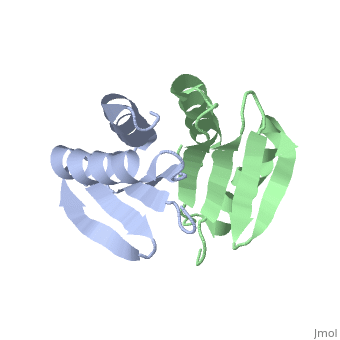2jwk
From Proteopedia
(Difference between revisions)
| Line 1: | Line 1: | ||
| - | + | ==Solution Structure of the periplasmic domain of TolR from Haemophilus influenzae== | |
| - | === | + | <StructureSection load='2jwk' size='340' side='right' caption='[[2jwk]], [[NMR_Ensembles_of_Models | 20 NMR models]]' scene=''> |
| - | + | == Structural highlights == | |
| + | <table><tr><td colspan='2'>[[2jwk]] is a 2 chain structure with sequence from [http://en.wikipedia.org/wiki/Haemophilus_influenzae Haemophilus influenzae]. Full experimental information is available from [http://oca.weizmann.ac.il/oca-bin/ocashort?id=2JWK OCA]. For a <b>guided tour on the structure components</b> use [http://oca.weizmann.ac.il/oca-docs/fgij/fg.htm?mol=2JWK FirstGlance]. <br> | ||
| + | </td></tr><tr><td class="sblockLbl"><b>[[Related_structure|Related:]]</b></td><td class="sblockDat">[[2jwl|2jwl]]</td></tr> | ||
| + | <tr><td class="sblockLbl"><b>[[Gene|Gene:]]</b></td><td class="sblockDat">tolR ([http://www.ncbi.nlm.nih.gov/Taxonomy/Browser/wwwtax.cgi?mode=Info&srchmode=5&id=727 Haemophilus influenzae])</td></tr> | ||
| + | <tr><td class="sblockLbl"><b>Resources:</b></td><td class="sblockDat"><span class='plainlinks'>[http://oca.weizmann.ac.il/oca-docs/fgij/fg.htm?mol=2jwk FirstGlance], [http://oca.weizmann.ac.il/oca-bin/ocaids?id=2jwk OCA], [http://www.rcsb.org/pdb/explore.do?structureId=2jwk RCSB], [http://www.ebi.ac.uk/pdbsum/2jwk PDBsum]</span></td></tr> | ||
| + | <table> | ||
| + | == Evolutionary Conservation == | ||
| + | [[Image:Consurf_key_small.gif|200px|right]] | ||
| + | Check<jmol> | ||
| + | <jmolCheckbox> | ||
| + | <scriptWhenChecked>select protein; define ~consurf_to_do selected; consurf_initial_scene = true; script "/wiki/ConSurf/jw/2jwk_consurf.spt"</scriptWhenChecked> | ||
| + | <scriptWhenUnchecked>script /wiki/extensions/Proteopedia/spt/initialview01.spt</scriptWhenUnchecked> | ||
| + | <text>to colour the structure by Evolutionary Conservation</text> | ||
| + | </jmolCheckbox> | ||
| + | </jmol>, as determined by [http://consurfdb.tau.ac.il/ ConSurfDB]. You may read the [[Conservation%2C_Evolutionary|explanation]] of the method and the full data available from [http://bental.tau.ac.il/new_ConSurfDB/chain_selection.php?pdb_ID=2ata ConSurf]. | ||
| + | <div style="clear:both"></div> | ||
| + | <div style="background-color:#fffaf0;"> | ||
| + | == Publication Abstract from PubMed == | ||
| + | TolR is a part of the Pal/Tol system which forms a five-member, membrane-spanning, multiprotein complex that is conserved in Gram-negative bacteria. The Pal/Tol system helps to maintain the integrity of the outer membrane and has been proposed to be involved in several other cellular processes including cell division. Obtaining the structure of TolR is of interest not only to help explain the many proposed functions of the Pal/Tol system but also to gain an understanding of the TolR homologues ExbD and MotB and to provide more targets for antibacterial treatments. In addition, the structure may provide insights into how colicins and bacteriophages are able to enter the cell. Here we report the solution structure of the homodimeric periplasmic domain of TolR from Haemophilus influenzae, determined with conventional, NOE-based NMR spectroscopy, supplemented by extensive residual dipolar coupling measurements. A novel method for assembling the dimer from small-angle X-ray scattering data confirms the NMR-derived structure. To facilitate NMR spectral analysis, a TolR construct containing residues 59-130 of the 139-residue protein was created. The periplasmic domain of TolR forms a C 2-symmetric dimer consisting of a strongly curved eight-stranded beta-sheet, generating a large deep groove on one side, while four helices cover the other face of the sheet. The structure of the TolR dimer together with data from the literature suggests how the periplasmic domain of TolR is most likely oriented relative to the cytoplasmic membrane and how it may interact with other components of the Pal/Tol system, particularly TolQ. | ||
| - | + | The Periplasmic Domain of TolR from Haemophilus influenzae Forms a Dimer with a Large Hydrophobic Groove: NMR Solution Structure and Comparison to SAXS Data(,).,Parsons LM, Grishaev A, Bax A Biochemistry. 2008 Mar 11;47(10):3131-42. Epub 2008 Feb 12. PMID:18269247<ref>PMID:18269247</ref> | |
| - | + | ||
| + | From MEDLINE®/PubMed®, a database of the U.S. National Library of Medicine.<br> | ||
| + | </div> | ||
==See Also== | ==See Also== | ||
*[[TolR|TolR]] | *[[TolR|TolR]] | ||
| - | + | == References == | |
| - | == | + | <references/> |
| - | < | + | __TOC__ |
| + | </StructureSection> | ||
[[Category: Haemophilus influenzae]] | [[Category: Haemophilus influenzae]] | ||
[[Category: Bax, A.]] | [[Category: Bax, A.]] | ||
Revision as of 09:26, 30 September 2014
Solution Structure of the periplasmic domain of TolR from Haemophilus influenzae
| |||||||||||


